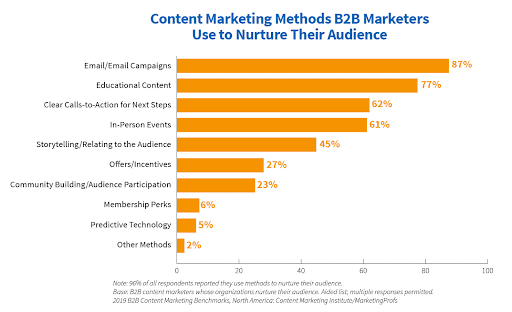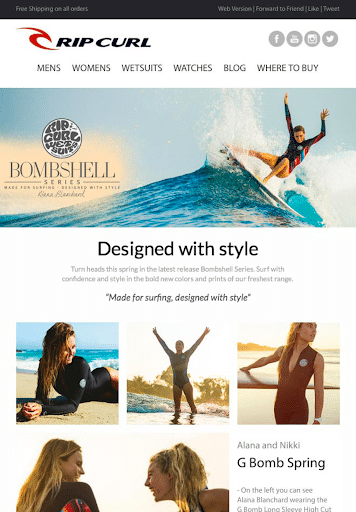10 steps to revamping your email marketing strategy
Not long ago, cold calls and mailers were the go-to marketing method of communicating with prospects and customers. Then, about a decade ago, email became every marketer’s go-to.
But today, as information is being shared in more places than ever before, some companies are shifting their attention to other mediums, such as social media, as their primary communication method.
So, does email marketing still matter? Yes, of course, and maybe even more so than before.
According to Content Marketing Institute, email campaigns are still used 87% of the time by B2B content marketers to nurture their audience, making it by far the most common method. You have to assume B2C marketers feel similarly.
Source: Content Marketing Institute
With such a large number of businesses still relying on email marketing, how do you create a campaign that will stand out from the crowd and, more importantly, prove to be successful for your company? Let’s take a look together:
10 ways to optimize your email marketing strategy
You wouldn’t launch a new product without careful research and preparation. Running a successful email campaign should be handled in the same way.
The steps you need to take before you even begin building your emails may be some of the most important to determine the overall success of your campaign.
Here are ten tips you should follow to when building an email marketing campaign:
1. Determine your goals.
First things first: you need to determine what you are trying to accomplish when you set out to create an email marketing strategy.
Are you looking to sell an additional number of specific products? Or maybe you need to increase conversion by a specific percentage. Whatever the reason, you need to ensure all action items from this point on are completed with those goals in mind.
Selecting your overall goals can also make it easier for you to determine the return on investment (ROI) of your campaign. Emails generally have one of the best ROI of all marketing activities— for every dollar spent, the average company in the U.S. gets $44 back.
By taking inventory of the big-picture scope of your current projects and future deadlines, you can establish reasonable benchmarks to measure your success along the way.
2. Choose your tools.
Once you’ve established your goals, you need to make sure you have the tools in place to be successful.
The best and easiest way to do this is to invest in email marketing software. The best programs on the market today have a myriad of features which allow you to customize your email template, import and segment contact lists, run tests to optimize performance, automate campaigns, and track and analyze your results.
Sure, you could tackle all of the responsibilities individually. But utilizing software will streamline your operation and improve your campaign.
3. Select your audience.
Your next step is to determine who will receive your emails. This is also known as your target audience.
Think about who will be using your product or service. This could be based on location, demographics, age, etc. These are the people you want to target with your emails.
If you need help determining your exact target audience, just consider what your competitors are doing, then adjust according to your company’s unique goals.
4. Populate your contact list.
Now that you know who you want to target, you need to figure out how to get their contact information. Here are several easy and effective ways to build a strong and reliable email list:
- Events: Collect email addresses at your booth, or if you are presenting, offer to share your presentation or another resource in exchange for an email address.
- Your website or blog: Put a form on your website or blog that asks visitors to provide their email addresses in exchange for updates, special deals, company information, newsletters, exclusive content, etc.
- Social media: You’ll use pretty much the same principle here as a form on your website but presented to your social networks.
It may sound tempting and easy, but steer clear of purchased email lists. Not only can these lists have unreliable contacts, but you risk violating spam laws by emailing these people without them opting in.
5. Determine your segments.
You’re not going to send the same email to everyone in your list at the same time.
For instance, your list of 100,000 contacts may include half new prospects and half existing customers. While it makes sense to send your prospects an email detailing the benefits of your company, this content is not relevant to your existing customers. You can solve this problem by segmenting your contact list.
When you segment your lists, you’re basically breaking them up into smaller groups or buyer personas. You could segment by their phase in the customer journey, location, and demographics—just to name a few. The more tailored your email is to your specific audience, the better it will perform.
6. Map out your plan of attack.
Now you need to determine what you will send to your audience and when. The majority of customers say they want to receive emails at least monthly or at least weekly. You need to find the appropriate cadence for your contacts.
In addition, you need to make sure your emails are relevant. Your messaging should deliver value to your audience and give them a reason to engage. It’s up to you to determine what that will be based on your business and your customers’ needs.
7. Design your templates.
Part of determining the best content for your campaigns is figuring out how to present it.
Using graphics and images generally work well for catching your readers’ attention and highlighting your main messaging. Here’s a great example from Rip Curl:
This sample template does a great job of using images to tell the story. The email illustrates a new style of swimwear and uses photos to show how it looks in various poses.
However, you don’t need to use images to have a successful email campaign. Sometimes the simplest styles are the best. Consider this great segmented newsletter from Meetup:
This example relies on short and concise text with appropriate links to engage with readers. You’ll need to select a template that works for your readers and see how it performs.
8. Send the email.
Once you’ve built your emails and determined the segment to which it will be sent, it’s time to hit the ‘send’ button and feel accomplished!
9. Look at your numbers.
Now that your emails have been sent, the process is over, right?
Not quite!
In order to determine the success of your email strategy, you need to take a careful look at your email analytics.
Emails tend to perform differently in each industry, but several good email marketing averages to measure your success are a 24% open rate and a 4% click-through rate. This means nearly a quarter of your email recipients open your email and 4 out of 100 recipients click somewhere in your email.
If your open rate is down, it likely means your subject line and segment needs to be improved. If your click-through rate is down, the content in the email needs to be improved to be more relevant to your audience.
A few other metrics to consider include:
- Conversation rate: The percentage of recipients that convert into qualified leads or customers, depending on your goals.
- Bounce rate: The number of emails that aren’t delivered, which is an indication of a poor email list or old addresses.
- Unsubscribe rate: The number of recipients who opt-out from receiving your emails. This is an indication of an email that doesn’t offer the right content or is sent to the wrong segment. Although it might seem like a negative, unsubscribes can actually improve your list quality.
- Spam rate: The number of recipients who mark your email as spam, which is an indication you are sending to people who have not opted in to receive your messages
10. Adjust your campaign.
Rome wasn’t built in a day, and your email campaign likely won’t be a success from day one.
It’s important to constantly make adjustments to your strategy in order to find the sweet spot.
Consider A/B testing subject lines, email copy, templates, graphics, and the times and days you are sending your email. You might be surprised how a little change can drastically improve your email performance.
Keep testing and optimizing, and before long, you’ll have a successful email strategy.
Wrap up
It’s important you don’t rush into your email marketing strategy. Your team should take time to determine goals and do your research to learn what results are realistically attainable.
Once you realize what you’d like to achieve, take your time to carefully craft the look and feel of your strategy so you’re providing compelling, relevant, and helpful information with each message that you’re sending.
Remember, your email strategy will not be perfect.
If you’re lucky, you may see some early success. But it will probably take some time—and testing—to really achieve results that will impact your bottom line.
MOST RECENT ARTICLES
Want to engage your audience and grow your brand? Try Emma's robust easy-to-use product today.
















